How to Draw a Cape on a Person TUTORIAL
In this lesson, we'll expect at how to depict a face and we'll encompass several approaches. We'll begin by exploring the process of drawing a confront from the frontal view. In these series of steps, we'll comprehend the general locations of the facial features and acquire a few proportional comparisons that you can utilise to ensure that your facial features are in the right location.
Many people make mistakes when drawing faces because they don't fully empathise facial proportions. Proportion refers to the relationship in size and placement between one object and another.
In that location are many formulas that one tin adapt to describe the facial features in the correct location. There's a simple approach - ane that I first learned and is great for beginners. Then there is the more than complex approach using illustrator, Andrew Loomis' guidelines.
How to Draw a Face from the Front - Stride Past Step
We'll first discuss Loomis' approach, which is more complex, just more accurate. If you lot observe that this approach is a bit difficult for yous, you lot can skip to the simpler approach further down the page. Call back, either way, the goal is to create a disarming drawing of a face so either arroyo you accept is fine.
Footstep 1 - Draw a Circle and a Cross
We'll offset describe a circumvolve with ii intersecting lines that connect straight in the eye. The circle represents the top portion of the head. We'll utilise the intersecting lines to decide the locations of the facial features.
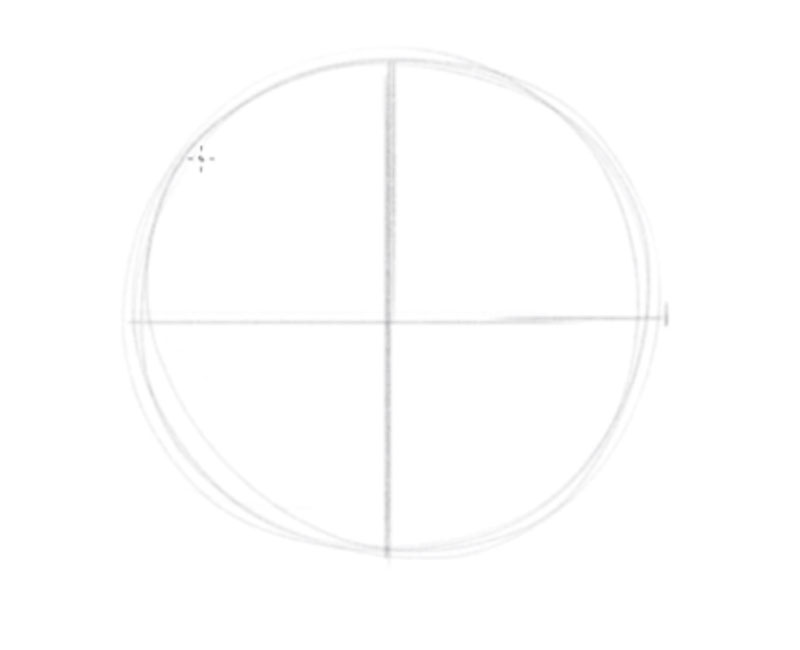
Step 2 - Draw a Square inside the Circumvolve
Next, nosotros'll draw a square in which each corner touches the circle. This square will eventually represent the edges of the face. The top line will eventually become the bottom hairline. The bottom line will become the nose line, while the eye line will go the forehead line.
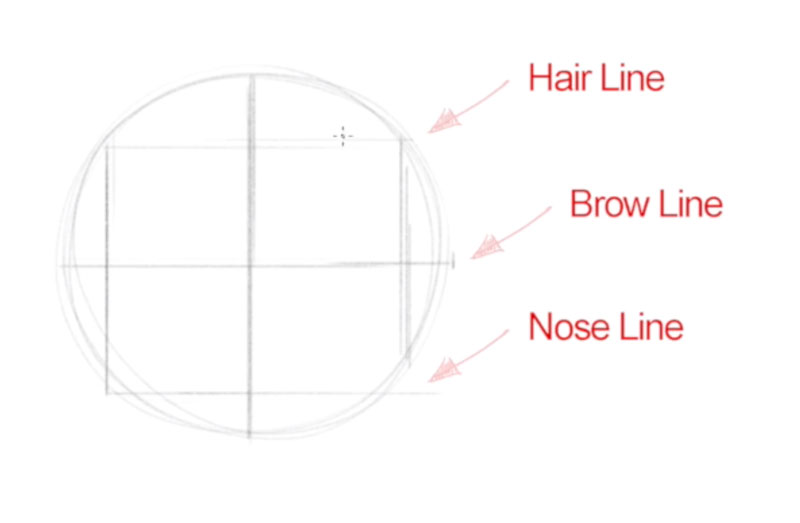
Step 3 - Draw the Chin
At present we'll measure out the altitude from the eye line to the bottom line. You can apply your pencil to do this. From the bottom line of the square, apply this measurement to mark the location of the bottom of the chin. Then, draw the edges of the chin from each side of the square so that they connect at your marked location.
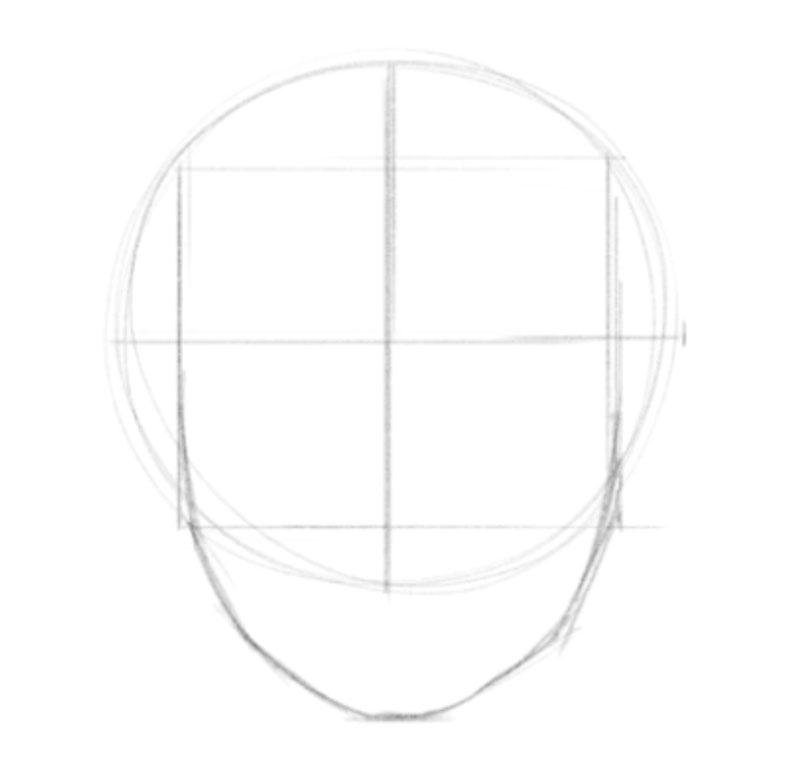
Step iv - Locate the Optics
At present nosotros have the basic construction of the shape of the face in place. We'll side by side locate the eyes. We tin can use the height of the caput to aid the states determine the location of the eyes on the face. The eyes are by and large plant on a line in the center of the head.
The brow line is represented by the middle line that we drew in footstep 1. And then we know that the eyes should be found simply beneath this line, in the eye of the caput. We can describe a line hither for the "center line".
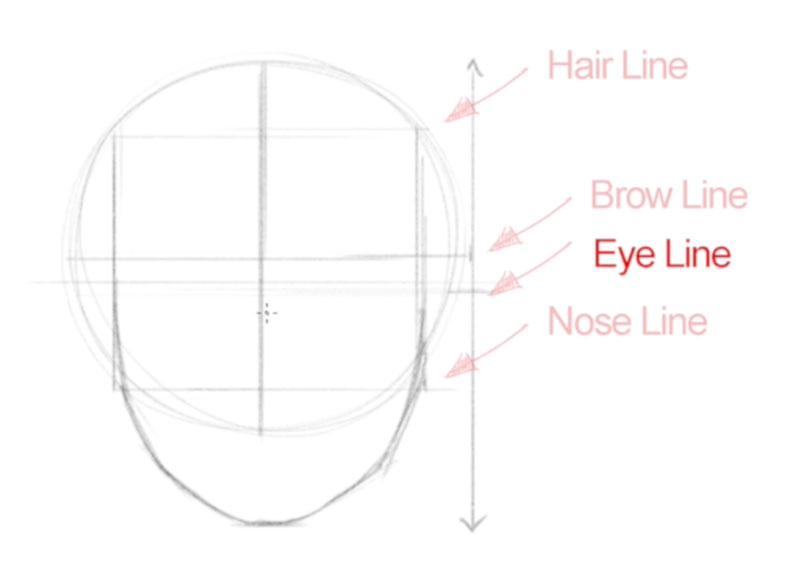
Step five - Depict the Eyes
At present that nosotros know where our eyes are located on the face up, we can draw them. There's another measurement to continue in mind. Nosotros likewise should consider the width of the eyes. The width of the head, from ear to ear, generally measures the same length of 5 "eyes". This means that if we want to draw the eyes with accurate proportions, then we need to draw them then that they match this estimate measurement.
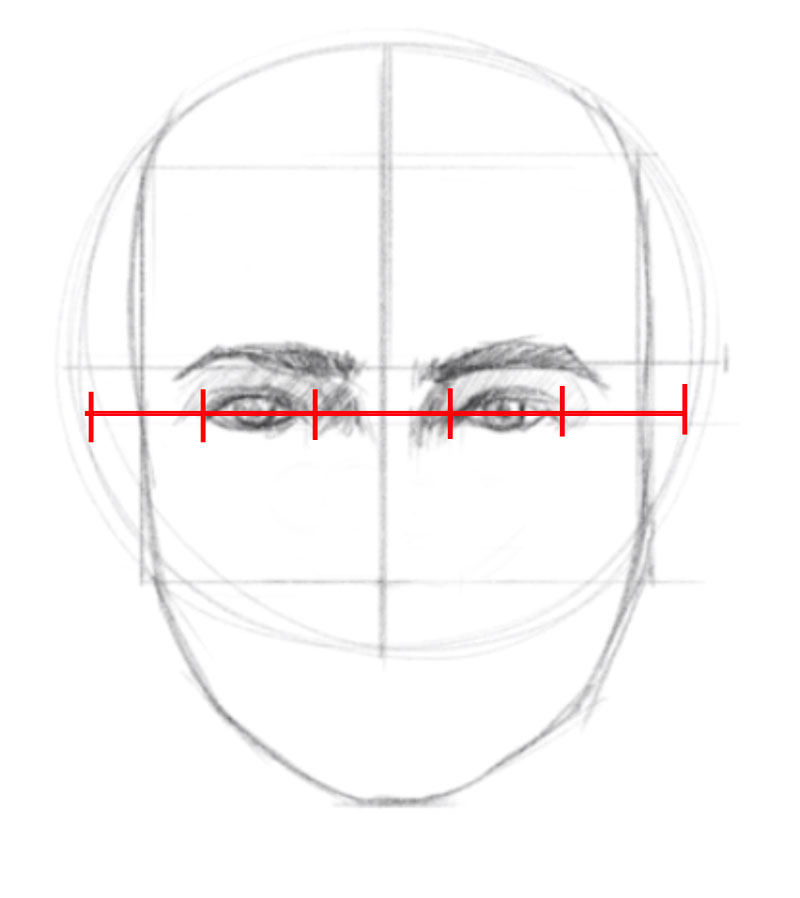
Step six - Locate and Draw the Olfactory organ
Moving downwards the face, we'll next describe the nose. The bottom of the nose can be constitute on the bottom line of the square that we drew in step two. The width of the nose varies from person to person, but is generally equally wide as the inside corners of the eyes.
It may be helpful to draw two light lines downwardly from the within corners of the eyes to help you find the width of the olfactory organ.
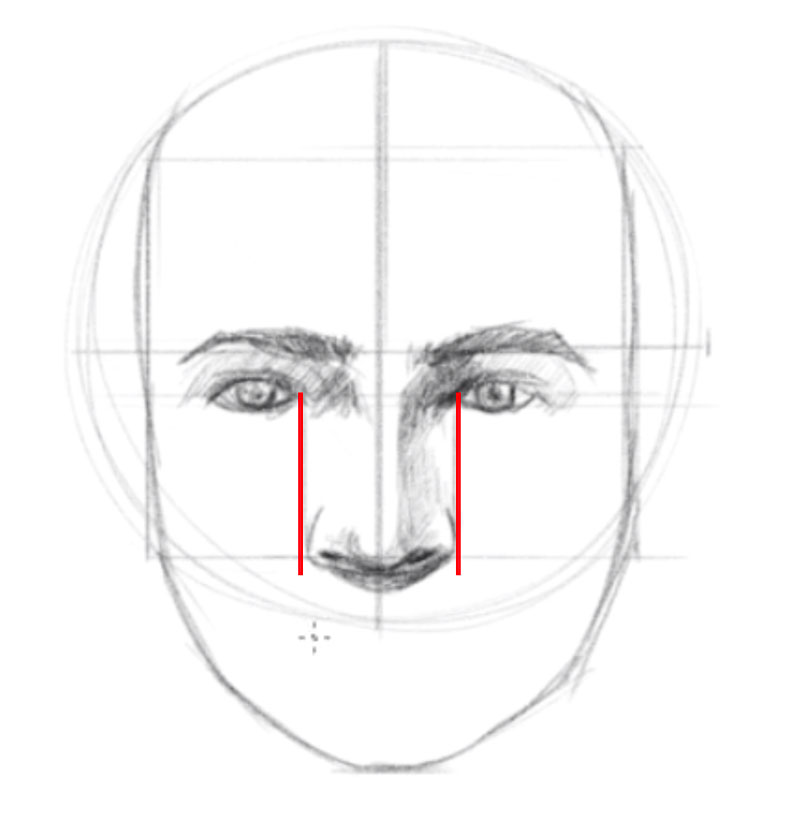
Pace 7 - Locate and Draw the Oral cavity
We find the mouth slightly college than half-way between the bottom of the nose and the chin. Of course, this measurement varies from person to person. We can draw a line to marking the positioning of the mouth.
We can employ the eyes to help us determine the width of the oral cavity. The corners of the oral cavity generally align with the inside edges of the pupils. It may be helpful to draw light lines from the pupils to the "oral cavity line".
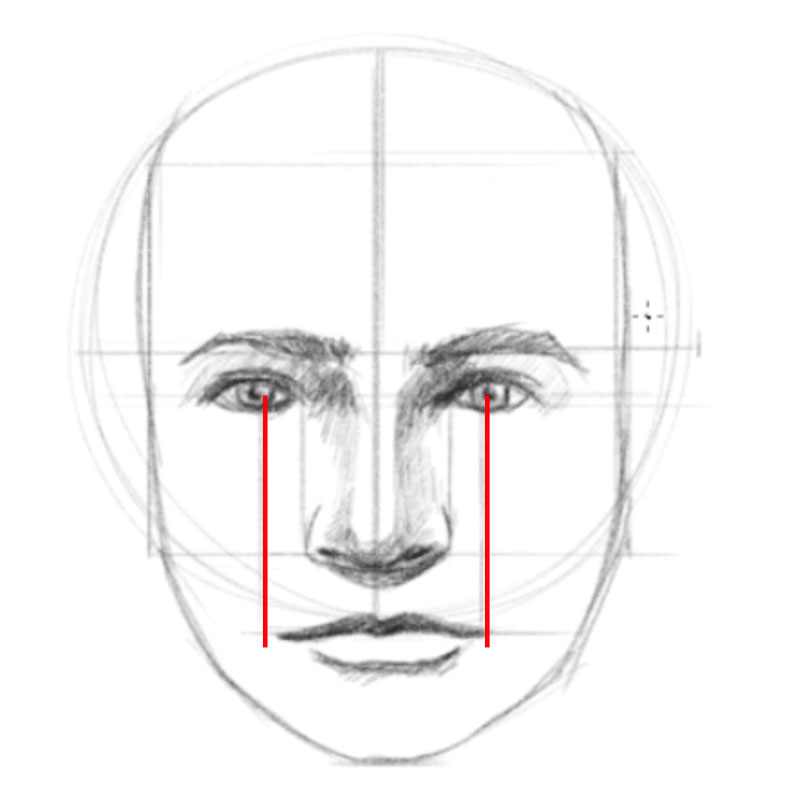
Step eight - Draw the Ears
Next, we'll draw the ears. Here again, we can use the locations of the features of the face up to help united states of america decide the location of the ears. The top of the ears will mostly marshal with the brow line, while the bottom of the ears align with the nose line.
Go along in mind that the ears come out of the head and extend upward slightly. This means that the ears volition extend outward from the head, well-nigh the middle line.
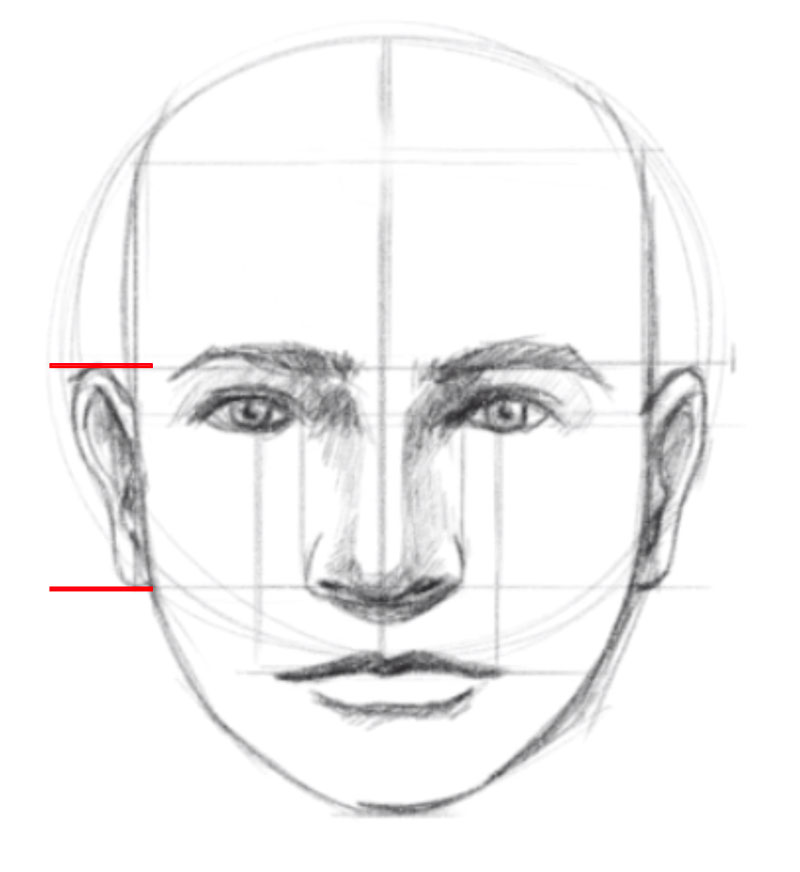
We've only sketched in a couple of loose ears for this lesson. If y'all desire to accept a closer look at drawing an ear, check out this lesson...
- How to Depict Ears
Step ix - Draw the Hairline
Now we'll depict the hairline. If you're drawing someone that has long hair that overlaps the forehead, the hairline may not exist visible, but information technology's still of import to know where it'southward located. The hairline is found on the tiptop edge of the square that we drew in footstep two.
Hairlines vary greatly from person to person. In this example, we'll draw a widow's superlative pattern.
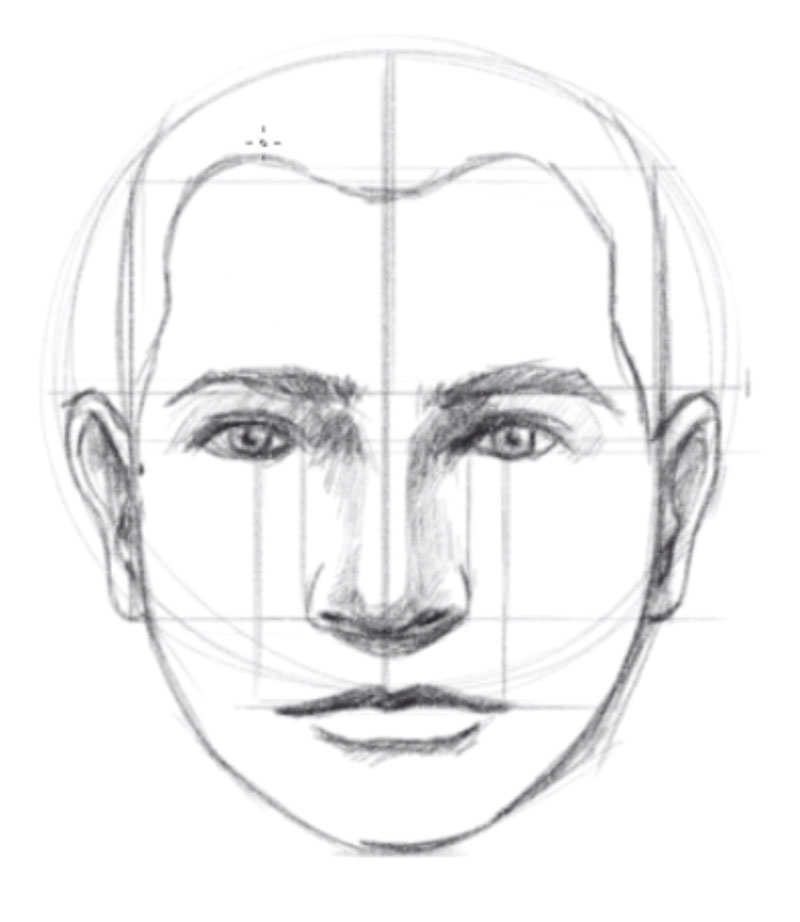
Step 10 - Describe the Pilus
Now that nosotros accept the hairline in place, we tin can depict the hair. Shorter hair extends only slightly off of the top of the head, while longer or bushier hair may extend quite a chip. In both cases, even so, the hair extends out from the caput and should non be drawn directly on the head.
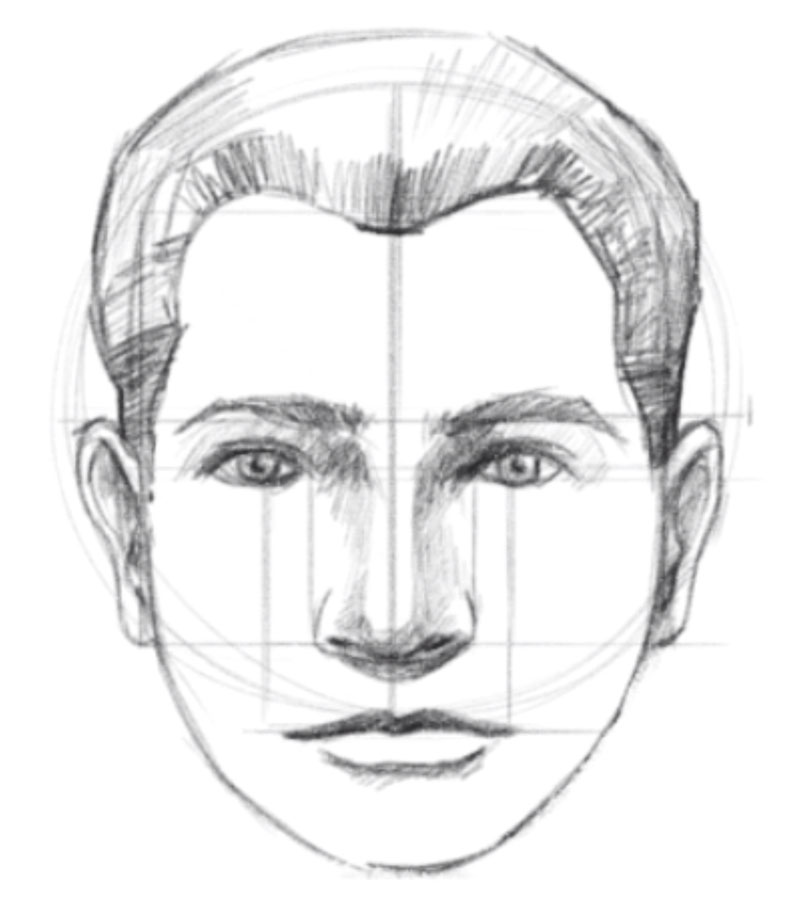
Want more instruction on drawing hair? Check out this lesson...
- How to Draw Hair
Step 11 - Add the Neck
At present nosotros need to add a cervix to our floating head. The tendency of nearly showtime artists is to make the neck too narrow. Generally speaking, the neck extends down from the lesser of the ears. Female necks are slightly more slender, while the necks of males are broader.
To describe the neck, we'll just extend 2 lines down from the bottom of the ears.
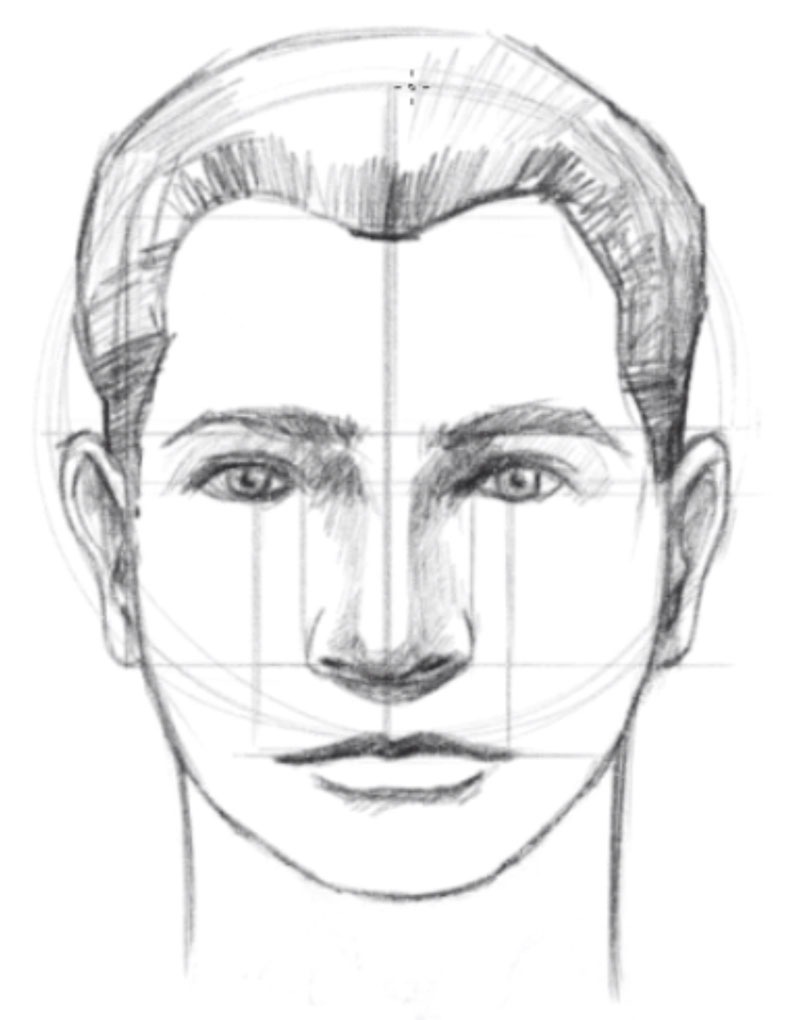
How to Draw a Face up From the Side (Profile)
If y'all want to describe a face up from the side or profile view, these aforementioned proportional measurements apply. We'll simply change the location of the features, positioning them on the side of the caput.
In fact, nosotros tin can beginning the process in exactly the same way - starting with a circle with intersecting lines.
Pace 1 - Draw a Circle, a Square, and Intersecting Lines
We'll start in the aforementioned style that we did before by drawing a circumvolve, two intersecting lines, and a square that makes contact with the circumvolve at all four corners.
Here again, the tiptop line of our square will become the hairline. The centre line will become the brow line and the lesser line will go the olfactory organ line.
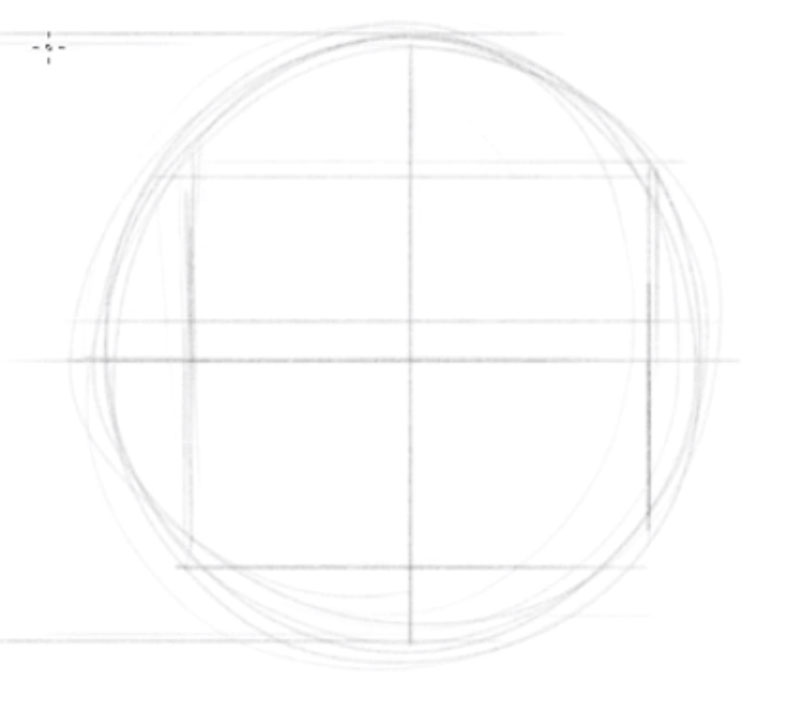
Step 2 - Draw a Line from the Height of the Head to the Chin
We'll adjacent mark the location of the bottom of the chin. We tin measure the altitude from the center of the square to the bottom and use this measurement to mark the bottom of the chin.
With a mark in place for the chin, we'll draw the front edge of the face. In this case, our subject is facing to the left, and then nosotros'll bring a curved line downwardly from the top of the head to the bottom of the chin.
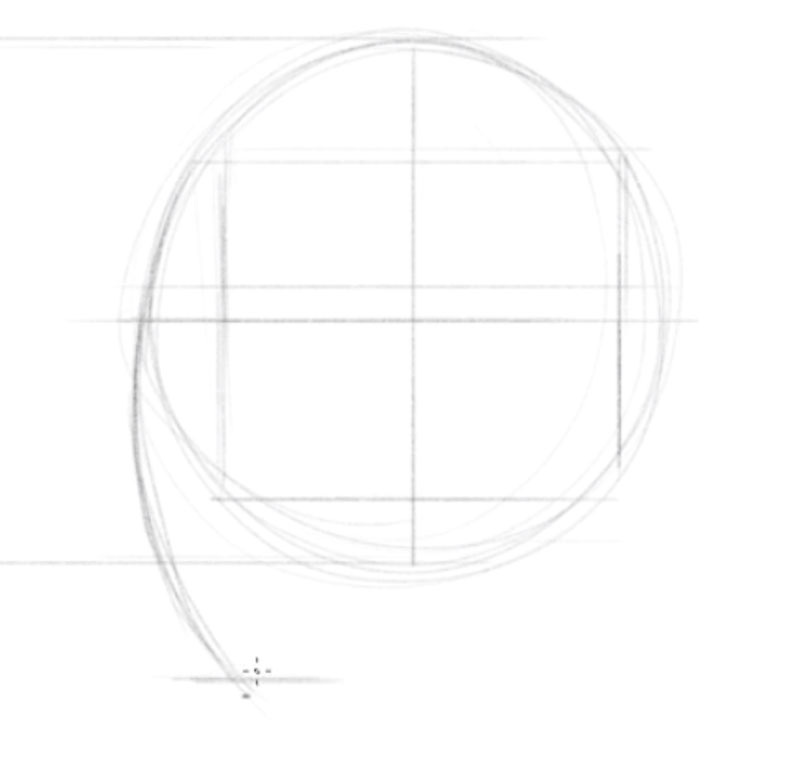
Step 3 - Add a Line from the Bottom of the Chin to the Eye of the Square
Side by side, we'll draw a line from the bottom of the chin to the center point on the bottom of the square. This line represents the jawline. This line will curve slightly in most cases.
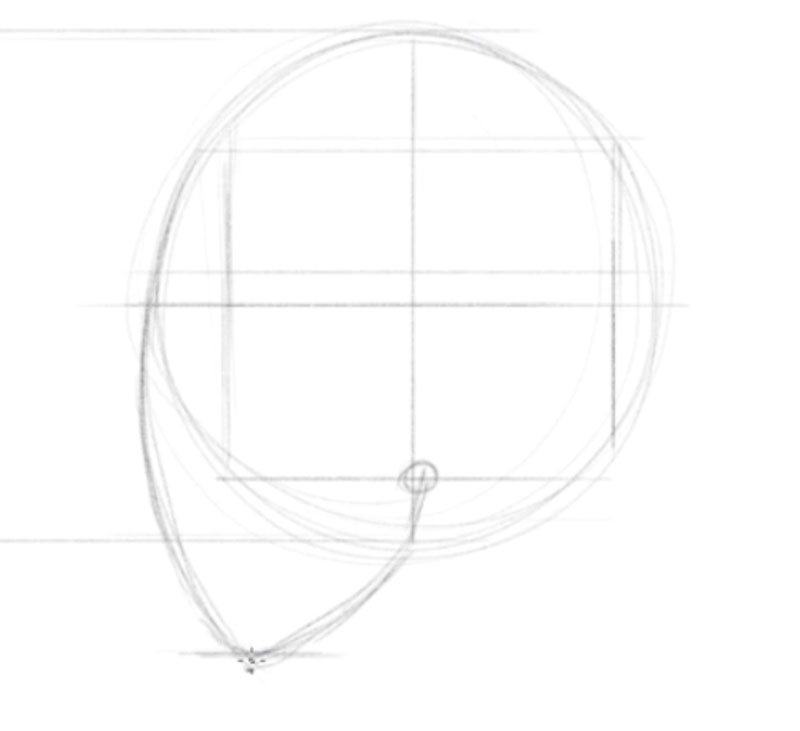
Step 4 - Determine the Location of the Optics
Now we'll measure out to the centre of the head and identify a line to correspond the eye line. Again, this line should be fatigued just underneath the forehead line.
Nosotros tin can likewise use the circumvolve that we drew with the bottom of the square to describe the backside of the head. Call back near the construction of the skull here as you draw this line.
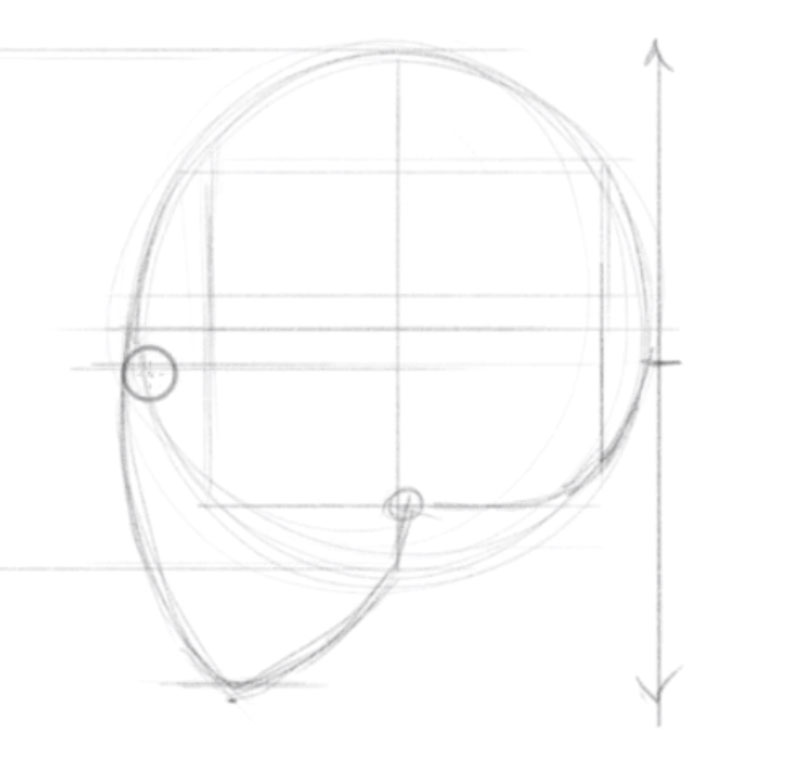
Step 5 - Describe the Facial Features and Add Shading
Now that we have an thought of the location of the facial features, we can draw them in using contour lines. We'll also add a chip of shading here to make the face up have a sense of course.
Notice how the eyes are set back from the front border of the face and how the lips and mouth recede at a diagonal towards the neck.
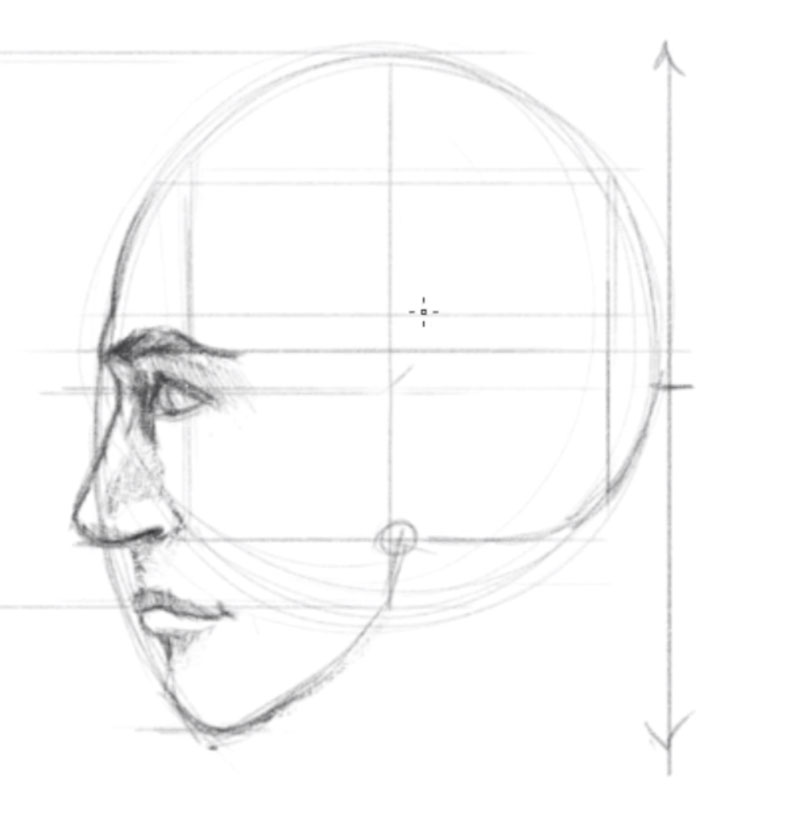
Stride 6 - Draw the Ear on the Side of the Confront
We can utilize our middle line, olfactory organ line, and middle line to draw the ear on the side of the face. Since our subject is facing towards the left, the bulk of the ear will exist found on the correct side of our heart line.
Every bit we discussed before, the line fatigued for the ear will start on the eye line, extend upwards to the forehead line and then curve downward, touching the nose line.
Nosotros'll also go alee and depict a contour line for the outer edge of the hair and a couple of contour lines for the neck in this pace.
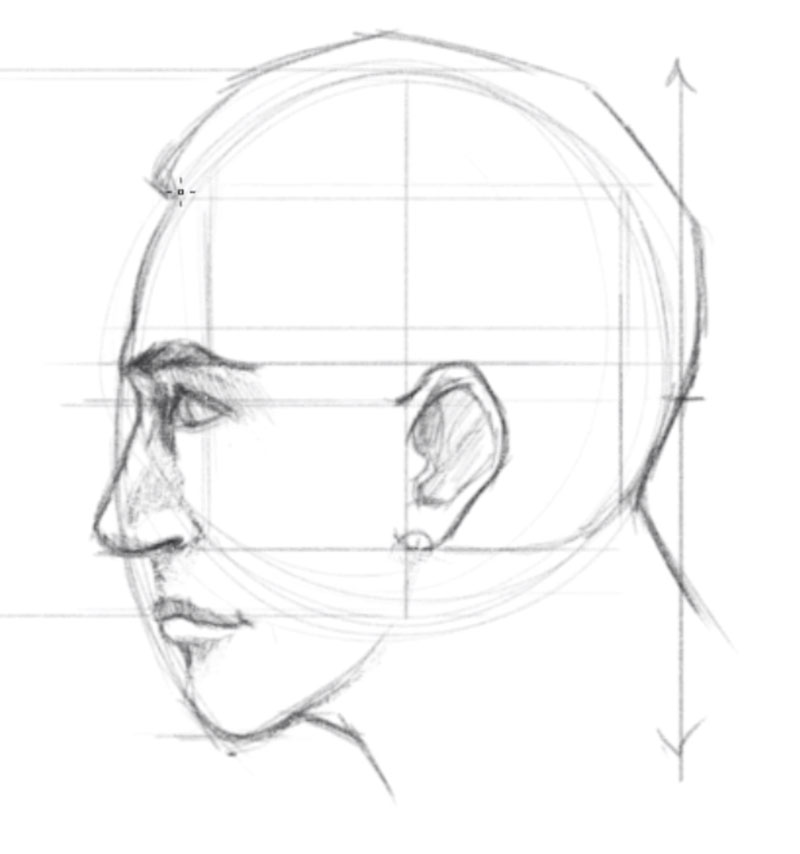
Pace 7 - Add the Hair
Nosotros'll proceed the hair mode consequent with our showtime drawing and draw the hairline. In this case, the line extends back before making its way downwards to the ears.
Nosotros'll also add a few hints of shading to make the hair feel like a form.
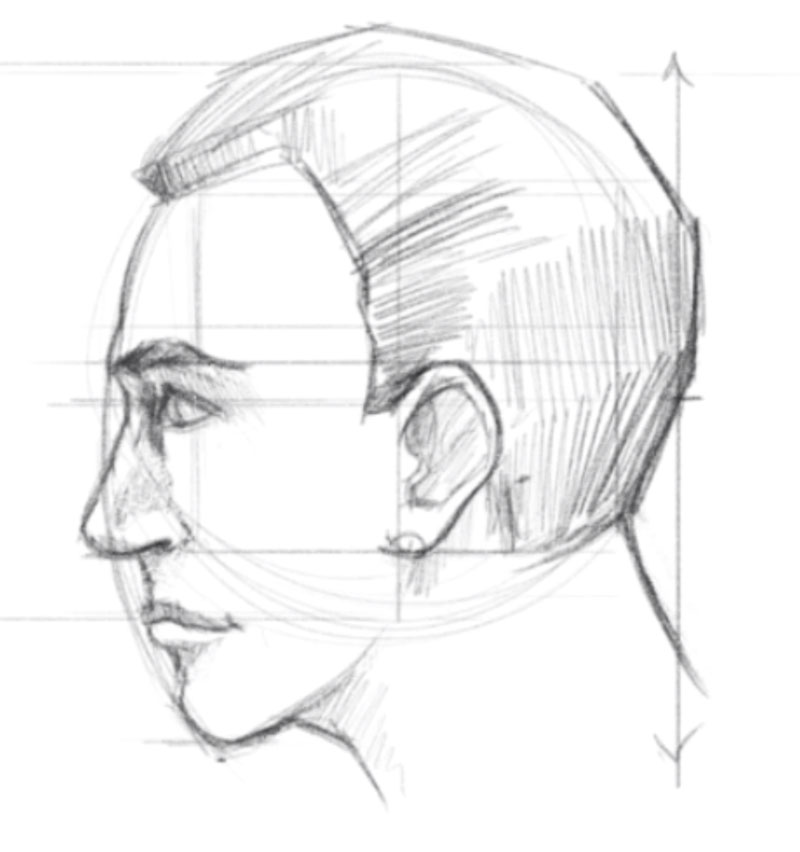
Summing Upwards The Andrew Loomis Arroyo to Drawing a Face
(Some of the following links are chapter links which means we earn a small commission if you purchase at no additional cost to you lot.)
Andrew Loomis is revered for his step by step approach to drawing heads. As we covered above, his approach divides the head into manageable geometric shapes. Each feature on the face has a specific location relative to the geometric configuration prepare in the early stages of the drawing process. Because this method is then accurate, it's slap-up to use for drawing a caput from imagination.
Merely this approach is not limited to cartoon faces from imagination. Information technology also works when drawing a face from observation. Nosotros just have to keep in mind that every person is different and variations of these specific proportions volition be noticed.
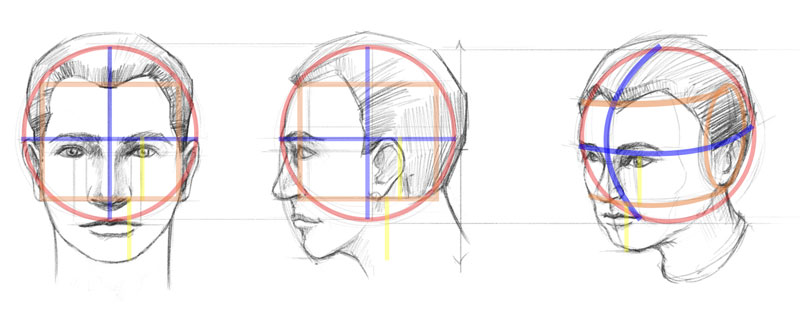
Here's a look at a face and caput fatigued from imagination using the Loomis approach combined with a simpler approach which we discuss a piddling farther downward this page. All of the relationships and proportions are identified with the guidelines discussed.
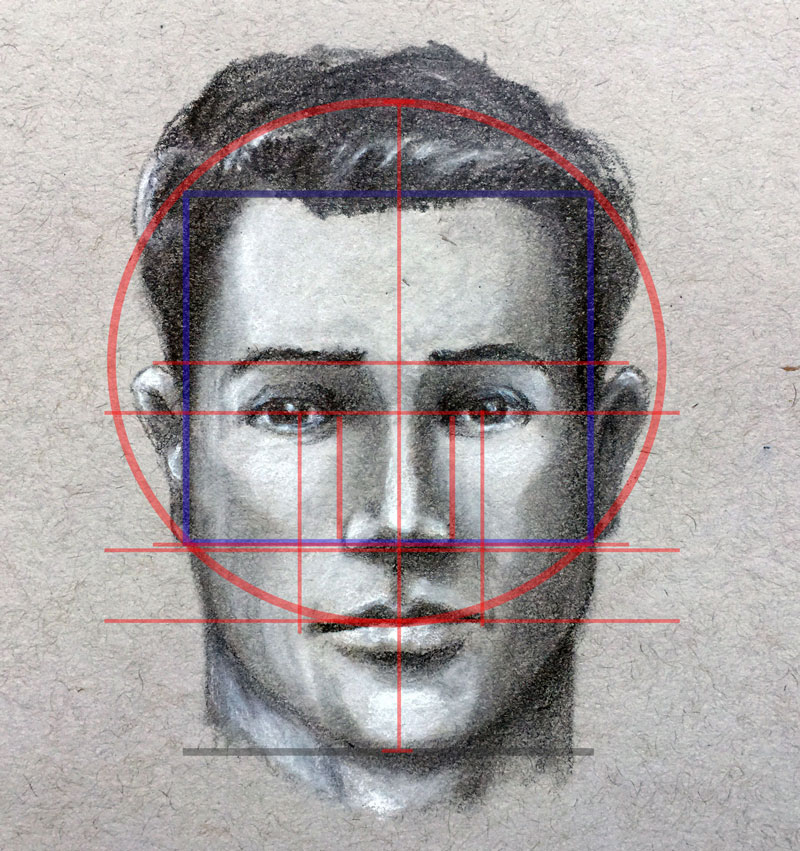
For more on the Loomis method for drawing heads, cheque out Module four from the "Portrait Drawing The Smart Way" grade or y'all tin can cheque out his book here .

A Simple Approach to Cartoon a Face
Some may discover the Loomis Method a little cumbersome for drawing. Luckily, there is a simpler approach. This approach borrows ideas from the Loomis Method, merely simplifies a few of the steps. This formula should be used to aid yous see and compare. In each stage of the formula, analyze each characteristic and draw what you encounter. The result will be a representational portrait of the person you are cartoon with all of the features in the right place.
Cartoon a portrait is very much like cartoon any other subject matter. You have to closely observe the subject in society to describe it accurately. Of class portrait drawing is especially delicate because the goal is to make the portrait resemble the subject closely.
If you know the person, the force per unit area to produce accuracy can exist daunting. But every artist, no matter what their skill level, should take heart. Even the most experienced and well-known portrait artists are presented with challenges. Consider these two quotes from one of the all-time portrait painters of all time, John Vocaliser Sargent...
"Every time I pigment a portrait, I lose a friend."
"A portrait is a painting in which something is wrong with the oral cavity."
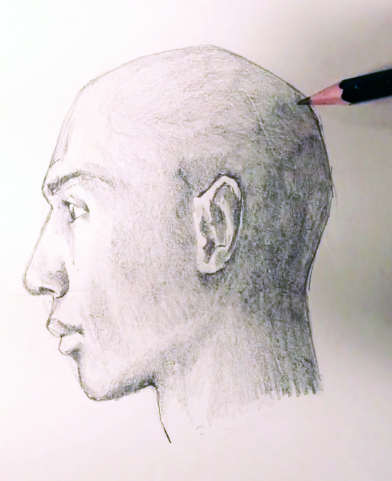
Most of us tin can chronicle with both of these quotes. Nosotros've all felt the force per unit area when drawing or painting a portrait to get in look exactly like our discipline - especially when that subject is a friend. For some of usa, the pressure level is and so great, we avoid portraits all together.
Information technology'southward oft hard to pinpoint a trouble in a portrait. We tin see that something isn't quite right, just finding the solution or the set up can actually throw some of u.s.a.. Often information technology's a combination of issues that lead to a "less than perfect" portrait. Perhaps something "is incorrect with the oral cavity".
Fifty-fifty though representational portrait cartoon is reliant on skilful observation and accurate mark-making, we can even so follow a simple process that will lead to improve results in our attempts.
At present, let's accept a look at the simpler arroyo to cartoon a face.
I've taken all of the steps to cartoon a face with this simpler approach and put them into ane image. The pace by step instructions tin be found underneath the epitome. Y'all'll notice that some of the steps are the same as we discussed before, with the exception of using the square to determine the hairline, brow line, and nose line.
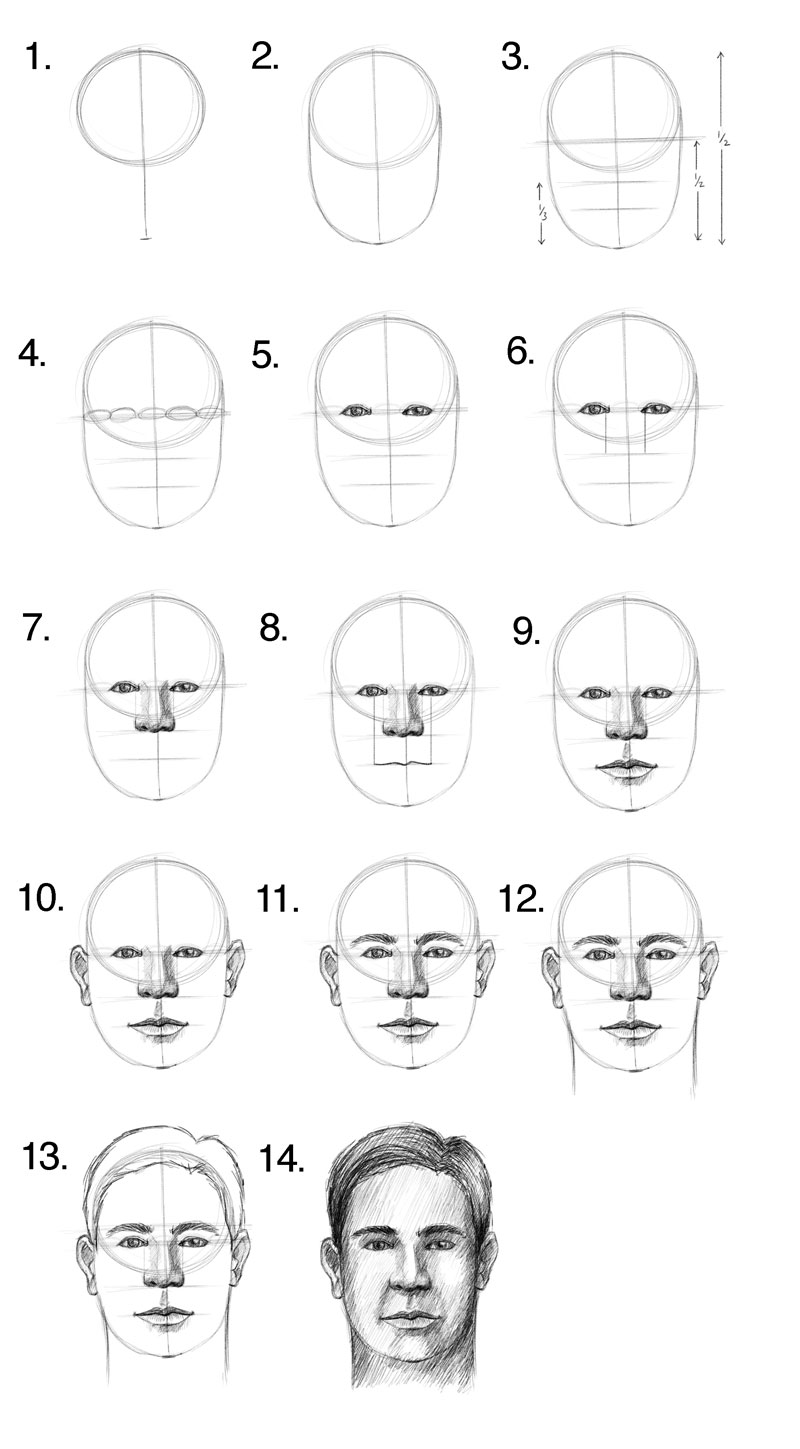
The offset step is to depict a circle to represent the cranium. Next, a line can be drawn to make up one's mind the length of the confront (Step 1). For most faces, this line should be approximately double the length of the original circle.
Next, lines are drawn from the bottom of that line to the edges of the circle creating the shape of the face (Step 2). From here, nosotros can locate the positions of the facial features.
The "eye" line is in the centre of the face up. (Your eyes aren't way upwardly on your brow, so resist the temptation to put them in that location.) A line is drawn to stand for the eye line (Footstep 3).
The "olfactory organ" line is found in the centre of the "middle" line and the bottom of the mentum. When it comes to facial proportion, most noses will end at this line (Footstep 3). However, in that location are exceptions to every rule. Some people take really long noses and some have actually curt ones.
The mouth line is found approximately one-third of the fashion down in between the nose line and the bottom of the chin. A line is loosely drawn for its location (Step 3).
Next, we'll concentrate on the eyes. To observe the overall width of the eyes, describe 5 oval shapes across the centre line. Most faces are about "v optics" wide. Patently, people only have two eyes. The "five eyes" simply aid to determine the width of the eyes (Step 4).
Once we know the width of the optics are accurate, we can describe them in the proper location (Step v).
At present, we'll determine the width of the olfactory organ. For almost people, the width of the nose volition align with the inside corners of the eyes. We tin simply depict two lines downwards from the within corners of the optics to the nose line to detect the relative width of the nose (Pace 6).
In one case we know the width of the olfactory organ, we can depict it in place (Pace 7).
At present, we can figure the width of the mouth. This measurement varies from person to person, but for most folks, the width of the oral fissure aligns with the inside portions of the iris or the educatee. So, we'll simply draw a line straight downwardly from this location to the mouth line to find the corners of the mouth. We'll draw a line here to indicate where the upper lip meets the bottom lip (Step 8).
Then we tin depict the upper and lower lips, knowing that the mouth is in the correct spot (Step 9).
Now for the ears. We'll extend the eye line out to determine the location where the top portion of the ears meet the caput. They extend upward a scrap and line up with the brow line. The bottom of the ears conveniently align with the nose line (Step 10).
In one case we have the ears in place, we tin can add the eye brows. Nosotros'll utilise the tops of the ears to make comparisons. For near people, the forehead line aligns with the tops of the ears (Step 11).
Before addressing the pilus, we'll add a neck. The neck extends down from the bottom of the ears. For females, this lines extends inward a flake - resulting in a smaller cervix. For males, this line all the same comes in a bit, but to a lesser degree. It's virtually straight down from the bottom of the ears (Step 12).
The shape of the hair is added next. In almost cases, the hair extends off from the top of the cranium and may overlap portions of the brow (Footstep 13).
Lastly, shading is added to develop the illusion of class (Pace xiv).
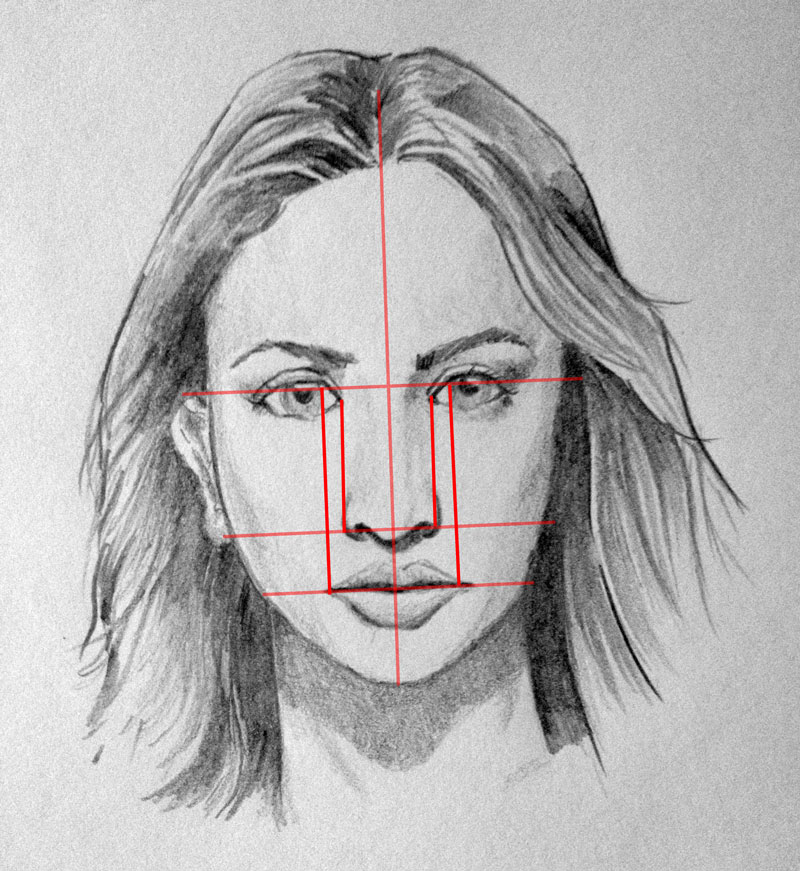
Reviewing the Generalized Locations of Facial Features
- The eyes are found in the middle of the head.
- The corners of the inside of the eyes more often than not line up with the edges of the olfactory organ.
- The "mouth" line is nigh ane-third below the "nose" line and the bottom of the mentum. This line represents where the peak lip meets the bottom lip.
- The within portions of the pupils or the iris generally line upwardly with the corners of the rima oris.
- The ears are usually institute between the "eye" line and the "nose" line, but extend up to the forehead line.
When drawing faces, apply these standards to help you get your facial proportions correct. Remember, you must look and study your subject. While these standards use to most of u.s., they do not utilise to all of united states of america.
Shading a Face
Knowing where to place the facial features is conspicuously of import, but in order to communicate a face in a drawing, we'll also need to add some shading. Shading is just the process of manipulating value (the darkness or lightness of a colour).
The form of the face is adult though the use of value and tone. The relationships of specific values inform the viewer of the location and strength of the light source. It is ultimately the behavior of light on the head which creates the illusion of form.
To better understand how calorie-free behaves, we tin consider the planes of the head and face. Past breaking the face down into elementary planes, we can better comprehend how light behaves.
When shading, it'southward helpful to remember of the head in terms of flat planes. Nosotros can see these planes illustrated below...
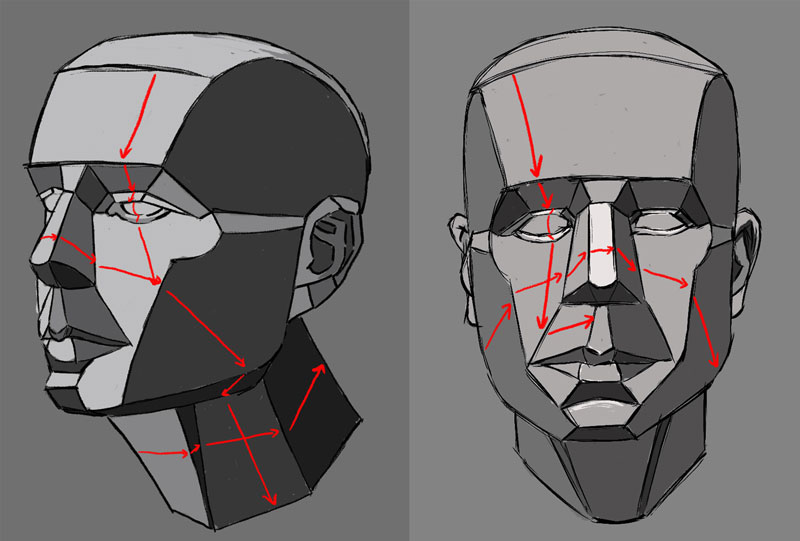
The planes of the confront change direction in infinite. These changes in direction produce different values depending on the location and forcefulness of the low-cal source. In most cases, the light source will originate from above. This produces areas of darker tone in locations that recede and lighter ones in locations that protrude.
This means that recesses effectually the eyes, under the olfactory organ, bottom lip, and mentum are generally shaded with darker values. Areas that protrude, such every bit the nose, cheek bones, chin, and lower lip consist mostly of lighter values.
Almost faces will take polish transitions or gradations from calorie-free to nighttime. Creating smooth transitions in value are essential for communicating the texture of skin.
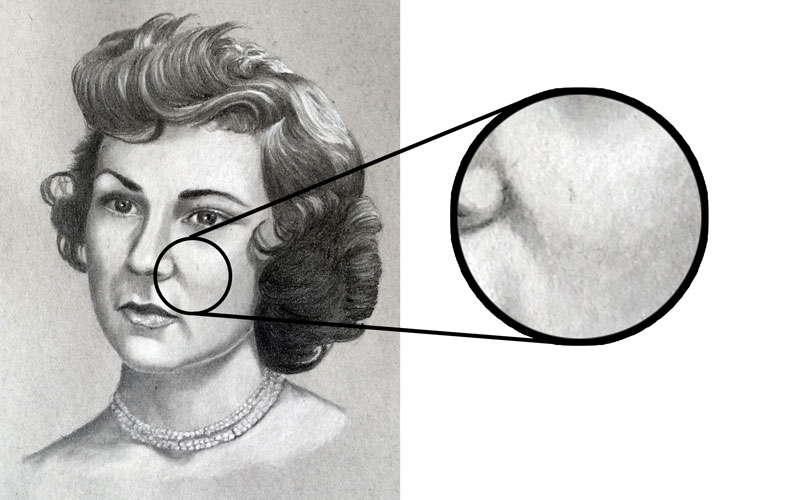
How y'all arroyo shading a face will depend on the medium that you use to draw the face up. For graphite, or pencil, y'all can simply adjust the corporeality of pressure level that you place on the pencil. For very smooth or subtle transitions, y'all may choose to use a blending stump.
Conclusion
When cartoon a portrait, we take to remember that there's no "one size fits all" solution. In that location will be slight proportional differences from one person to the next. Nosotros can apply the techniques explored in this lesson to help us better sympathize the locations of the features of the face up. But if we want our portrait drawings to capture the likeness of the person, then we must rely on observation to capture all of the nuances.
Now that y'all know how to depict a confront and the locations of the facial features, you can depict anyone that you wish. Just remember, knowledge is only part of information technology. You must practice in social club to see the best results with your drawings.
DOWNLOAD HERE
How to Draw a Cape on a Person TUTORIAL
Posted by: johncombis.blogspot.com

Comments
Post a Comment